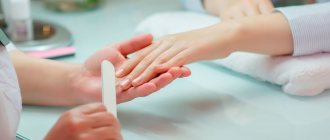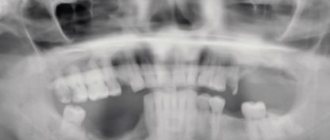If you look at someone's hands very carefully, then you can determine from them not only how neat this person is, but also find out certain information about his health. If the skin of your hands is clean and smooth, your nails are pink and smooth, then this indicates good health.
When they begin to flake and break, the hands look unkempt and untidy. At the same time, a person loses self-confidence and involuntarily tries to hide his hands from the eyes of strangers. Such untidiness is often associated not only with cosmetic problems, but also with certain abnormalities that occur in the body.
A peeling, uneven nail plate is a consequence of dystrophic changes in the structure of the plate. It gradually becomes thinner and splits into separate scales.
This condition is characterized by severe fragility, brittleness, dullness, and dry nails. They grow very slowly, the surface of the plate becomes rough.
Doctors call this condition onychodystrophy . How this condition is treated, as well as the reasons for this phenomenon, will be discussed in the article below.
Why do nails peel?
If your fingernails peel, the causes of this phenomenon can be associated with many factors.
However, to understand this phenomenon you need to know about the structure of the nail. Its plate is made up of thin, tightly pressed horny plates of keratin , which determine the density, as well as layers of water, making it elastic. The nail plate contains a large number of different microelements: zinc, chromium, calcium, etc.
The nail plate grows when the germ cells in the light part of the base of the nail, which looks like a crescent, divide. The nail grows towards the free edge, gradually pushing old cells forward.
Structural structure of nails
Layering of fingernails occurs under the influence of a number of different factors. In this case, small cracks and gaps appear between the horny layers, and then a cavity appears, stratifying the nail.
If nails peel and break, the reasons can be both external and internal.
External reasons
The influence of external factors, exposure to chemicals, which leads to dehydration of the plate:
- often lamination is due to the fact that a person comes into contact with household chemicals, hot water, alkali, etc.;
- use of varnishes containing formaldehyde ;
- frequent extensions;
- improper removal of artificial nails;
- using products containing acetone to remove or dilute nail polish;
- constant hypothermia or exposure to dry air;
- mechanical damage: improper pedicure and manicure, bruises and compression, occupational injuries to musicians and people working with certain machines and units, etc.
Internal reasons
Often parents cannot understand why a child’s nails begin to peel at the age of 2. The answer to the question of why a child’s toenails or fingernails peel is often due to internal reasons.
- iron deficiency anemia , which develops due to a lack of iron in the body;
- dysfunctions of the digestive tract, liver, biliary tract, endocrine system, in which the metabolism of minerals and their distribution in the body is disrupted;
- malnutrition, when the diet lacks a number of vitamins , protein, magnesium, calcium, phosphorus. Very often it is this factor that affects the layering of nails in children;
- since nails are a derivative of the skin, their condition worsens with diseases and skin lesions: lichen ruber, eczema , psoriasis , congenital epidermolysis , fungal diseases of the nails and skin;
- hormonal imbalance in adolescence, during menopause (at this time there is a deficiency or, conversely, an excess of certain hormones);
- poisoning with heavy metals, as well as certain drugs;
- pregnancy period , when minerals entering the body go to the fetus, which develops (if there is a deficiency of a certain mineral, then the fetus takes it from the mother’s body).
Psychological reasons
Onychophagia - compulsive nail biting
Often the answer to the question of why nails break is psychological.
The following causes of brittle nails are identified:
- the presence of a bad habit of constantly gnawing on them, knocking them on hard surfaces, etc.;
- onychotillomania is a pathological condition in which a person seeks to destroy his own nails using any tools;
- onychophagia - uncontrolled biting;
- stress and depression .
Thus, there can be many reasons why women’s fingernails break. And the condition can only be improved if the cause of brittle fingernails is correctly identified.
Application of oils
For enhanced nutrition, extracts of almond, tea tree, avocado, and rosemary are rubbed into the nail plates. Chamomile, lemon, and eucalyptus oils are effective. Esters of thyme, ylang-ylang, and bergamot prevent delamination. These products are applied in pure form and added to hand creams.
Nourish and moisturize unrefined, cold-pressed oils of olive, mustard, coconut, and sunflower. To achieve a lasting result, leave the oil on the plates overnight, wearing cotton gloves on your hands.
Conditions in which nails peel and break
Onychoschisis
In this condition, a median or symmetrical leaf-shaped splitting of the plate occurs. Only the free edge is split in the transverse direction, and its main part is not damaged. The nail may grow and not break, but its free edge becomes thinner.
Causes:
- occupational disease due to the influence of alkaline solutions;
- aggressive influence of varnish, etc.;
- injuries that are constantly repeated;
- improperly performed manicure;
- the influence of polishing tools used during manicure;
- low quality varnishes;
- x-ray dermatitis ;
- congenital epidermolysis .
Sometimes the color changes to off-white or greyish. Most often, plates are affected on the index, ring and middle fingers.
Treatment for brittle nails in this condition consists of long-term intake of vitamin A , ingestion of a 10% gelatin solution, and injections of vitamin B12 .
Onycholysis
A disease of a trophic nature. The plate separates from the nail bed. As a result, the nail plate completely or partially peels off from the side or from the free edge.
Causes:
- professional injuries;
- influence of alkalis or acids;
- various skin diseases - eczema , psoriasis , streptoderma etc.;
- endocrine disorders;
- fungal infections;
- syphilis.
The nail plate peels off and becomes white-gray.
It can affect either one or several plates on any fingers, including the toes.
Treatment depends on the cause and severity of the lesion. Syntomycin ointment is applied to the affected area for several days . It is also recommended to lubricate the affected area with Castellani Liquid . During the treatment period, you need to take vitamin A and gelatin orally.
Onychorrhexis
Longitudinal grooves appear on the nails; they start from the free edge, then split in the longitudinal direction. The process is complicated by the appearance of deep cracks.
Causes:
- lichen planus;
- eczema;
- psoriasis;
- diseases of the digestive system;
- lack of vitamins.
Alternating stripes, light and dark, appear on the affected plates. The nails on the fingers and toes, one or several plates at once, may be affected. The use of vitamin A for 1 month is indicated.
Brittle nails
In this condition, the free edge of the nail plate breaks off, and the top layer of the nail or all its layers are destroyed. As a result, the edge of the plate becomes uneven, resembling a fringe.
With this condition, the nail fold is often damaged. When the free edge is carefully cut away, the plate appears healthy. However, as it grows, the nails again become thin and brittle.
If a person has too thin fingernails, the reasons can be both external and internal.
Causes:
- improperly done manicure;
- influence of low temperatures and chemicals;
- endocrine disorders.
The color of the plate does not change, only its free edge becomes transparent or whitish, and chips of the plate are visible on it. As a rule, all nails are affected.
If your nails peel, what to do depends on the problem that caused such manifestations. In any case, if a person notices that over a period of time the fingernails or toenails become very peeling, or that the free parts of the nails are breaking, it is important to visit a dermatologist or mycologist.
But in some cases, only a specialist gastroenterologist or endocrinologist can tell you what to do if your fingernails peel, having discovered the internal cause of such problems during the research process.
Sometimes it is necessary to examine the plate for fungus and microelements; the doctor also often prescribes laboratory blood tests and hormonal tests.
A doctor can prescribe effective treatment only after determining the cause of the problem. Therefore, advice on what to do at home if your nails peel is not always relevant.
Use of medications
Sometimes the doctor prescribes certain medications to improve the condition of the nails. As a rule, dietary supplements and complexes of vitamins and minerals are prescribed. However, for those who are interested in what to do to prevent nails from peeling, it is important to take into account that such products need to be used for at least one month. Only in this case can you get a positive effect.
Proper nutrition
In addition to medications, for those for whom the question of how to strengthen their nails so as not to peel is relevant, it is important to take care of proper nutrition. It is necessary that the diet contains a sufficient amount of protein foods, vegetables, fruits, as well as foods high in calcium - dairy products, green leafy vegetables, nuts.
Carrying out salon and physiotherapy procedures
If your nails constantly break, you can ask cosmetologists what to do. In beauty salons, special procedures are carried out that activate blood flow and accelerate regrowth.
- Paraffin nail application
This effect can be achieved using special procedures - wax and paraffin applications . To carry out this procedure, warm softened wax or paraffin is used, which is applied to the nail plate and soft tissue nearby and held for about 20 minutes. Those who have brittle nails should take into account that such procedures can be done at home.
- Professional nail care can improve the condition of your nails and give them a healthy look. Such procedures include aromatherapy, nourishing masks, and hand massage.
- The special Japanese manicure technique is also effective. It includes a hand massage, rubbing jojoba oil into the fingers, and after that a water massage of the hands. At the end of the procedure, a mineral mask and a special polishing powder containing beeswax are applied.
- The procedure for sealing nails - if the nails are very peeling and there is a need to completely renew the plate. During the procedure, a salt bath is made, the plate is treated with a sanding file, and oil with vitamins and natural wax are rubbed into the nail. After the procedure, the effect lasts about 3 months.
- Ultraphoresis of vitamins A and E is a procedure that allows you to “deliver” the necessary vitamins directly into the tissue. The procedure is carried out in courses of 10-15 sessions. A month later, you can conduct a second course of sessions.
- Diathermy - the procedure involves heating the distal hands in order to activate metabolic processes and blood flow.
- Hand massage allows you to improve tissue trophism and speed up metabolic processes. As a result, nail plates grow faster.
Popular recipes
- With salt. Dissolve a large spoon of sea salt and 5 drops of iodine in 500 ml of water.
- Herbal collection . A tablespoon of chamomile, burdock root powder, and St. John's wort leaves is brewed with a glass of boiling water. Use after cooling.
- Lemon. Combine the juice squeezed from lemon (50 ml) with 200 ml of water. This bath is done no more than once every 7 days.
- With beer. Mix 100 ml of beer and apple juice and heat.
- Gelatinous. Dissolve 0.5 tbsp. l. gelatin in 200 ml oxen. After swelling, dip the nails into the jelly-like mass.
The duration of the procedures is 10-15 minutes.
What procedures can be done at home?
If you are concerned about splitting or crumbling toenails, you should first of all ask your doctor. But it also makes sense to carry out some procedures at home to improve the condition of your hands and nails.
- First of all, you should not neglect hand creams that you use every day. When applying the cream, you need to thoroughly rub it into the cuticle area and each finger. It is better to choose products that contain vitamins, minerals, and plant extracts. If the cream is used regularly, the condition of the nails will improve. You can choose creams: Folk Healer , DiaDerm , etc. The cost of such products is from 100 rubles.
- Therapeutic varnishes are special nail varnishes that peel and break, containing growth activators, vitamins and other useful substances. They seal the plate, protecting it from external influences. Some varnishes are also used as decorative ones. The cost of such funds is from 120 rubles.
- Nail wax – protects against splitting. Contains beeswax and is used at home. Price – from 130 rub.
- Healing mud – it contains many minerals and active substances. It is necessary to dilute the mud in hot water until it becomes viscous. After cooling to approximately 38°C, apply a large layer to the nails and leave for about 15 minutes. Wash off the dirt, immerse your hands in water with sea salt. Such procedures are carried out every day for a week. After some time, the course is repeated.
Biogel
The product, consisting of proteins, natural tree resins, minerals and vitamins, is intended to strengthen and treat microcracks in nails.
Algorithm for applying the cosmetic composition:
- for better adhesion, nails are polished and degreased;
- apply a primer so that the gel lasts at least two weeks;
- Using a flat brush, evenly cover the plates with a transparent product;
- place them under the lamp for a couple of minutes.
Transparent biogel is coated with colored varnish.
Traditional methods
Herbal masks
Herbal mask for nails
To prepare such a mask, any of the components must be crushed using a blender or grater. After mixing all the ingredients, apply the mask to the nails and distal phalanges of the fingers, leave for up to 15 minutes. The procedure should be carried out after a short massage or warming bath.
The following masks are useful:
- from cabbage and potatoes in equal proportions with the addition of cream;
- from carrots, with the addition of lemon juice and olive oil;
- from cottage cheese and sour cream;
- from bananas.
Wax film mask
You need to melt the wax in a water bath and cool it to normal temperature. Next, dip your fingertips into the viscous wax and remove, waiting until the wax hardens. You need to perform this procedure before going to bed, and in the morning, wash off any remaining wax on your fingers with water. Do this procedure 2-3 times every week.
Baths
Activating blood circulation will help improve tissue trophism. And this can be achieved if you regularly take baths with sea salt and essential oils.
To prepare such a bath, you need to take 1 liter of warm water, a couple of drops of any essential oil and 2 tbsp. l. sea salt. The essential oil is first dissolved in a few drops of vegetable oil. You need to keep your hands in the bath for 20 minutes, while performing a light nail massage. This procedure should be done 3 times a week.
Rubbing in medicated oils
Before going to bed, rub warm oil into each nail and soft tissue nearby. Lemon, sea buckthorn, avocado, olive, castor, and jojoba oils have a beneficial effect on the condition of the skin and nail plates.
Mask of iodine, clay and olive oil
You need to mix a little blue clay, warm olive oil and a few drops of iodine. After applying the mask to your nails, you need to wait 20 minutes. The procedure is carried out every day for a week.
Edible gelatin
You need to take edible gelatin jelly internally. It should be strong, and this jelly should be taken three times a day, 1 tbsp. l. for 3-4 months. The condition of your nails will improve significantly.
Sealing with wax
After a warm bath, paraffin or cosmetic wax is applied to the steamed plates. Distribute the product over the nail, adjacent soft tissues, and cuticle. Using a special file, the natural coating is polished until the fingertip glides over the nail.
In order for a glossy shine to appear and minor defects to become invisible, the procedure is repeated once every 1–2 weeks. A contraindication to the use of wax is thin, highly flaking plates.








